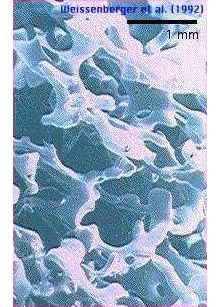
A resin cast of the microscopic brine channel system within the sea ice (modified after Weissenberger et al. 1992). About 10 to 30% of the ice volume is filled by a salty fluid (brine). The fluid is found in channels and pockets between and within the ice crystals, and forms the habitat for specialized sea ice biota. The diameter of these brine channels is normally less than 1 mm.
Arctic Sea Ice: Channels of Life
Rolf Gradinger
Assistant Professor
Institute of Marine Science
University of Alaska
Sea ice is a unique feature of the polar oceans. Its extent and thickness vary with the seasons. Ice is mainly formed during the winter months and melts in summer. In the Arctic, about 50% (7 million square km) of the winter sea ice melts during the warmer months. Typically, the thickness of "level" sea ice ranges from 2 to 4 m.
A Complex Structure
When sea ice forms, small spaces between the ice crystals remain and are filled with a salty solution called brine. Thus, sea ice consists of a mixture of ice crystals and brine channels, which form a three-dimensional network of tubes with diameters of a few micrometers to several cm. A specialized, sympagic (ice-associated) community has adapted to the variable conditions in this matrix. In 1852, Sutherland was the first to describe life in Arctic sea ice as "minute vegetable forms of exquisite beauty.” More than 100 years later, in 1985, Rita Horner published the milestone book Sea Ice Biota, which is till the standard textbook concerning the history and scientific progress of sea-ice research.
Since then, a wealth of new information has been gathered concerning the structural role of sea ice in both the Arctic and Antarctic. Studying the deep Arctic basins remained a challenge because of its permanent multi-year ice cover and many unsolved scientific questions. American and Russian drifting ice camps, such as T3 and NP22, produced the first descriptions of the biota in these deep basins. In 1994, the American trans-polar section revealed surprising insights into the biology of these areas, demonstrating large regional differences within the central Arctic, and much higher biological activity in the ice and the water column than was previously assumed.
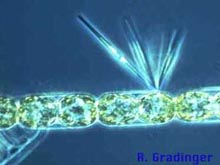
Light microscopic image of Arctic ice diatoms: Melosira arctica with ephytic diatoms. Unicelluar algae are the main primary producers in sea ice. More than 200 diatom species are known to grow in Arctic ice. Melosira arctica may grow within the brine channels, but also attaches to the bottom of ice floes. (Photo courtesy of Rolf Gradinger). Click image for larger view.
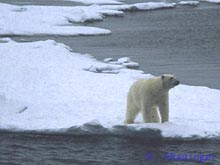
Sea ice is an important platform for many polar marine vertebrates. Polar bears use sea ice for migration and hunting. Bears are also excellent swimmer, and dive for several minutes at a time. (Photo courtesy of Rolf Gradinger). Click image for larger view.
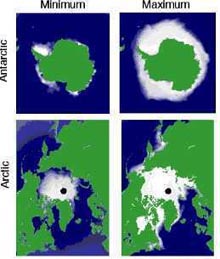
The sea ice extent in the Arctic varies seasonally from 7 (summer) to 14 (winter) million sq km. Summer melt occurs mostly on the vast Arctic shelves, while the central Arctic Ocean is covered by its unique, multi-year ice year-round. Click image for larger view.
A Microscopic Haven
Until recently, diatoms were considered to be the most important microorganisms inside the ice in terms of abundance and productivity, but a greater complexity is now appreciated. Several hundred unicellular species of algae are the main primary producers in this environment. Largely based on studies of sea ice known as "coastal fast" and "first-year level" ice, algal primary production contributes from 4 to 26% of the total primary production in seasonally ice-covered Arctic waters. This fraction can be expected to increase to 50% or more in perennially ice-covered waters due to the reduction in shortwave radiation penetrating the water column.
The production of dissolved organic material within the ice, mainly from the waste of ice algae, supports the growth of ice bacteria. Viruses and fungi also have a surprisingly high biological diversity within this extreme habitat. Small protozoans and metazoans, in particular turbellarians, crustaceans and rotifers, feed on ice algae and may, in certain periods or locations, restrict the development of algae.
Ice organisms tolerate a wide range of environmental conditions and experience rapid changes in light intensity, temperature and salinity. These fluctuations cause an uneven distribution of the ice biota within the floes, with the bulk of the organism biomass concentrated in the lowermost centimeters of ice floes. Strong interactions between the ice biota and plankton exist during periods of complete ice coverage.
A unique, partially endemic fauna, comprising mainly tiny crustaceans (amphipods), thrive permanently at the underside of the ice floes. Moving along the bottom of the ice, they feed directly on the bottom community and use brine channels as shelter against possible predators. They serve as mediators for particulate organic matter from the sea ice to the water column and benthos (ocean bottom) through the release of wastes, and as food for fish and seals.
Juvenile stages of zooplankton and meroplanktonic larvae of benthic organisms also enter the brine channel network on shallow Arctic shelves to feed on the rich ice bottom community while being relatively well protected from pelagic predators. In early spring, when the water column is still devoid of food, calanoid copepods, such as Calanus glacialis, perform diel (daily) vertical migrations from deeper parts of the water column to feed on phytoplankton that accumulate just below the ice. Thus, ice production is linked with the other Arctic marine realms through sedimentation and life cycles.
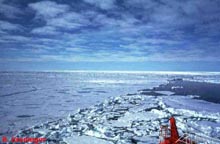
The ice cover of the Arctic Seas consists of individual ice floes separated by areas of open waters (leads or polynyas). Floe sizes range from several m to km. In summer, light blue, freshwater melt puddles may cover up to 60% of the surface of the ice. (Photo courtesy of Rolf Gradinger). Click image for larger view.
A Little-known Realm
The multi-year sea ice cover of the high Arctic, especially within the Canadian Basin, has been poorly studied. It may be that these areas, which form oases for species aggregations and production in the central Arctic, are the most sensitive to global climate change -- yet we know very little about them.
The extent of sea ice in the Arctic has decreased by about 2.8% per decade since 1978. Ice-thickness studies by submarines indicate a tremendous decrease in the mean ice thickness and ice volume.
Arctic exploration will tackle questions concerning the existence of life in this unique environment, looking for life on top of the ice, in its interior, and at the ice-ocean boundary layer. These studies will help us to understand the marine biology of the Arctic as a whole, and will also support climate predictions in an ever-changing world.
Sign up for the Ocean Explorer E-mail Update List.


























